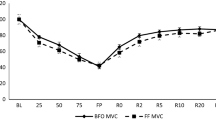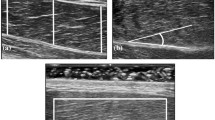Abstract
Purpose
This study aimed to determine whether men and women display a different magnitude of muscle fatigue in response to high-load (HL) and low-load blood flow-restricted (LLBFR) elbow-flexion exercise. We also explored to which extent both exercise protocols induce similar levels of muscle fatigue (i.e., torque decrement).
Methods
Sixty-two young participants (31 men and 31 women) performed dynamic elbow flexions at 20 and 75% of one-repetition maximum for LLBFR and HL exercise, respectively. Maximum voluntary isometric contractions were performed before and after exercise to quantify muscle fatigue.
Results
Men and women exhibited similar magnitude of relative torque decrement after both exercise protocols (p > 0.05). HL was more fatiguing (∆ torque output: 11.9 and 23 N.m in women and men, respectively) than LLBFR resistance exercise (∆ torque output: 8.3 and 15.4 N.m in women and men, respectively) in both sexes, but this was largely attenuated after controlling for the differences in volume load between protocols (p > 0.05).
Conclusions
These data show that torque decrement in response to LLBFR and HL dynamic elbow-flexion exercise does not follow a sexually dimorphic pattern. Our data also indicate that, if performed in a multiple-set fashion and prescribed for a given volume load, elbow-flexion LLBFR exercise induces similar levels of fatigue as HL acute training. Importantly, this occurs similarly in both sexes.

Similar content being viewed by others
Abbreviations
- ANCOVA:
-
Analysis of covariance
- ANOVA:
-
Analysis of variance
- AOP:
-
Arterial occlusion pressure
- HL:
-
High load
- LLBFR:
-
Low-load blood flow restriction
- MVC:
-
Maximum voluntary isometric contraction
- 1RM:
-
One-repetition maximum
References
Abe T, Kearns CF, Sato Y (2006) Muscle size and strength are increased following walk training with restricted venous blood flow from the leg muscle, KAATSU-walk training. J Appl Physiol 100:1460–1466
Barnett BE, Dankel SJ, Counts BR, Nooe AL, Abe T, Loenneke JP (2016) Blood flow occlusion pressure at rest and immediately after a bout of low load exercise. Clin Physiol Funct Imag 36:436–440
Brown LE, Weir JP (2001) ASEP procedures recommendation I: accurate assessment of muscular strength and power. J Exerc Physiol Online 4:1–21
Burgomaster KA, Moore DR, Schofield LM, Phillips SM, Sale DG, Gibala MJ (2003) Resistance training with vascular occlusion: metabolic adaptations in human muscle. Med Sci Sports Exerc 35:1203–1208
Clark BC, Manini TM, The DJ, Doldo NA, Ploutz-Snyder LL (2003) Gender differences in skeletal muscle fatigability are related to contraction type and EMG spectral compression. J Appl Physiol 94:2263–2272
Clark B, Manini T, Hoffman R, Williams P, Guiler M, Knutson M, McGlynn M, Kushnick M (2011) Relative safety of 4 weeks of blood flow-restricted resistance exercise in young, healthy adults. Scand J Med Sci Sports 21:653–662
Cook SB, Clark BC, Ploutz-Snyder LL (2007) Effects of exercise load and blood-flow restriction on skeletal muscle function. Med Sci Sports Exerc 39:1708–1713
Cook SB, Murphy BG, Labarbera KE (2013) Neuromuscular function after a bout of low-load blood flow-restricted exercise. Med Sci Sports Exerc 45:67–74
Counts BR, Rossow LM, Mattocks KT, Mouser JG, Jessee MB, Buckner SL, Dankel SJ, Loenneke JP (2016) Let’s talk about sex: where are the young females in blood flow restriction research? Clin Physiol Funct Imag 38(1):1–3
Dankel SJ, Jessee MB, Mattocks KT, Mouser JG, Counts BR, Buckner SL, Loenneke JP (2017a) Training to fatigue: the answer for standardization when assessing muscle hypertrophy? Sports Med 47:1021–1027
Dankel SJ, Mattocks KT, Jessee MB, Buckner SL, Mouser JG, Loenneke JP (2017b) Do metabolites that are produced during resistance exercise enhance muscle hypertrophy? Eur J Appl Physiol 117:2125–2135
Elias LJ, Bryden MP, Bulman-Fleming MB (1998) Footedness is a better predictor than is handedness of emotional lateralization. Neuropsychologia 36:37–43
Fahs C, Loenneke JP, Rossow LM, Tiebaud RS, Bemben MG (2012) Methodological considerations for blood flow restricted resistance exercise. J Trainol 1:14–22
Fatela P, Reis J, Mendonca G, Freitas T, Valamatos M, Avela J, Mil-Homens P (2017) Acute neuromuscular adaptations in response to low-intensity blood flow restricted exercise and high-intensity resistance exercise: are there any differences? J Strength Cond Res 32:902–910
Harris RC, Edwards RH, Hultman E, Nordesjo LO, Nylind B, Sahlin K (1976) The time course of phosphorylcreatine resynthesis during recovery of the quadriceps muscle in man. Pflugers Arch 367:137–142
Hunter SK (2016) Sex differences in fatigability of dynamic contractions. Exp Physiol 101:250–255
Hunter SK, Griffith EE, Schlachter KM, Kufahl TD (2009) Sex differences in time to task failure and blood flow for an intermittent isometric fatiguing contraction. Muscle Nerve 39:42–53
Husmann F, Mittlmeier T, Bruhn S, Zschorlich V, Behrens M (2018) Impact of blood flow restriction exercise on muscle fatigue development and recovery. Med Sci Sports Exerc 50:436–446
Janse de Jonge XA (2003) Effects of the menstrual cycle on exercise performance. Sports Med 33:833–851
Kagaya A (1992) Reduced exercise hyperaemia in claf muscles working at high contraction frequencies. Eur J Appl Physiol Occup Physiol 64:298–303
Karabulut M, Abe T, Sato Y, Bemben MG (2010) The effects of low-intensity resistance training with vascular restriction on leg muscle strength in older men. Eur J Appl Physiol 108:147
Keller ML, Pruse J, Yoon T, Schlinder-Delap B, Harkins A, Hunter SK (2011) Supraspinal fatigue is similar in men and women for a low-force fatiguing contraction. Med Sci Sports Exerc 43:1873–1883
Kim D, Loenneke JP, Ye X, Bemben DA, Beck TW, Larson RD, Bemben MG (2017) Low-load resistance training with low relative pressure produces muscular changes similar to high-load resistance training. Muscle Nerve 56:E126–E133
Labarbera K, Murphy B, Laroche D, Cook S (2013) Sex differences in blood flow restricted isotonic knee extensions to fatigue. J Sports Med Phys Fit 53:444–452
Laurentino G, Ugrinowitsch C, Aihara A, Fernandes A, Parcell A, Ricard M, Tricoli V (2008) Effects of strength training and vascular occlusion. Int J Sports Med 29:664–667
Loenneke J, Fahs C, Wilson J, Bemben M (2011) Blood flow restriction: the metabolite/volume threshold theory. Med Hypoth 77:748–752
Loenneke JP, Wilson JM, Marin PJ, Zourdos MC, Bemben MG (2012) Low intensity blood flow restriction training: a meta-analysis. Eur J Appl Physiol 112:1849–1859
Loenneke J, Thiebaud R, Fahs C, Rossow L, Abe T, Bemben M (2013) Blood flow restriction does not result in prolonged decrements in torque. Eur J Appl Physiol 113:923–931
Loenneke JP, Thiebaud RS, Abe T (2014) Does blood flow restriction result in skeletal muscle damage? A critical review of available evidence. Scand J Med Sci Sports 24:e415–e422
Maughan RJ, Nimmo MA (1984) The influence of variations in muscle fibre composition on muscle strength and cross-sectional area in untrained males. J Physiol 351:299–311
Maughan RJ, Harmon M, Leiper JB, Sale D, Delman A (1986) Endurance capacity of untrained males and females in isometric and dynamic muscular contractions. Eur J Appl Physiol Occup Physiol 55:395–400
Miller AEJ, MacDougall J, Tarnopolsky M, Sale D (1993) Gender differences in strength and muscle fiber characteristics. Eur J Appl Physiol Occup Physiol 66:254–262
Moore DR, Burgomaster KA, Schofield LM, Gibala MJ, Sale DG, Phillips SM (2004) Neuromuscular adaptations in human muscle following low intensity resistance training with vascular occlusion. Eur J Appl Physiol 92:399–406
Rakobowchuk M, Parsloe ER, Gibbins SE, Harris E, Birch KM (2013) Prolonged low flow reduces reactive hyperemia and augments low flow mediated constriction in the brachial artery independent of the menstrual cycle. Plos One 8:e55385
Ratamess N, Alvar B, Evetoch T, Housh T, Kibler W, Kraemer W (2009) Progression models in resistance training for healthy adults [ACSM position stand]. Med Sci Sports Exerc 41:687–708
Sakamaki M, Yasuda T, Abe T (2012) Comparison of low-intensity blood flow-restricted training-induced muscular hypertrophy in eumenorrheic women in the follicular phase and luteal phase and age-matched men. Clin Physiol Funct Imag 32:185–191
Sale DG (1988) Neural adaptation to resistance training. Med Sci Sports Exerc 20:S135–S145
Schott J, McCully K, Rutherford OM (1995) The role of metabolites in strength training. II. Short versus long isometric contractions. Eur J Appl Physiol Occup Physiol 71:337–341
Scott BR, Loenneke JP, Slattery KM, Dascombe BJ (2015) Exercise with blood flow restriction: an updated evidence-based approach for enhanced muscular development. Sports Med 45:313–325
Senefeld J, Yoon T, Bement MH, Hunter SK (2013) Fatigue and recovery from dynamic contractions in men and women differ for arm and leg muscles. Muscle Nerve 48:436–439
Shinohara M, Kouzaki M, Yoshihisa T, Fukunaga T (1998) Efficacy of tourniquet ischemia for strength training with low resistance. Eur J Appl Physiol Occup Physiol 77:189–191
Staron RS, Hagerman FC, Hikida RS, Murray TF, Hostler DP, Crill MT, Ragg KE, Toma K (2000) Fiber type composition of the vastus lateralis muscle of young men and women. J Histochem Cytochem 48:623–629
Takarada Y, Takazawa H, Sato Y, Takebayashi S, Tanaka Y, Ishii N (2000) Effects of resistance exercise combined with moderate vascular occlusion on muscular function in humans. J Appl Physiol 88:2097–2106
Thiebaud RS, Loenneke JP, Fahs CA, Rossow LM, Kim D, Abe T, Anderson MA, Young KC, Bemben DA, Bemben MG (2013) The effects of elastic band resistance training combined with blood flow restriction on strength, total bone-free lean body mass and muscle thickness in postmenopausal women. Clin Physiol Funct Imag 33:344–352
Umbel JD, Hoffman RL, Dearth DJ, Chleboun GS, Manini TM, Clark BC (2009) Delayed-onset muscle soreness induced by low-load blood flow-restricted exercise. Eur J Appl Physiol 107:687
Wernbom M, Paulsen G, Nilsen TS, Hisdal J, Raastad T (2012) Contractile function and sarcolemmal permeability after acute low-load resistance exercise with blood flow restriction. Eur J Appl Physiol 112:2051–2063
Yasuda T, Brechue WF, Fujita T, Shirakawa J, Sato Y, Abe T (2009) Muscle activation during low-intensity muscle contractions with restricted blood flow. J Sport Sci 27:479–489
Yasuda T, Abe T, Brechue WF, Iida H, Takano H, Meguro K, Kurano M, Fujita S, Nakajima T (2010) Venous blood gas and metabolite response to low-intensity muscle contractions with external limb compression. Metabolism 59:1510–1519
Yoon T, Doyel R, Widule C, Hunter SK (2015) Sex differences with aging in the fatigability of dynamic contractions. Exp Gerontol 70:1–10
Funding
This work was supported by the Foundation for Science and Technology (FCT), Portugal (PTDC/DTP-DES/5714-2014).
Author information
Authors and Affiliations
Contributions
GM, AB, PMH and PPC conceived the research. AB, CT, PM, GM and JC were involved in data collection. GM, AB and CVC wrote the manuscript. All authors read and approved the manuscript.
Corresponding author
Ethics declarations
Conflict of interest
The authors declare that they have no conflict of interest.
Ethical standards
The study complied with the principles set forth in the Declaration of Helsinki and was approved by the Faculty´s Ethics Committee (CEFMH No. 4/2017).
Additional information
Communicated by Guido Ferretti.
Rights and permissions
About this article
Cite this article
Mendonca, G.V., Borges, A., Teodósio, C. et al. Muscle fatigue in response to low-load blood flow-restricted elbow-flexion exercise: are there any sex differences?. Eur J Appl Physiol 118, 2089–2096 (2018). https://doi.org/10.1007/s00421-018-3940-x
Received:
Accepted:
Published:
Issue Date:
DOI: https://doi.org/10.1007/s00421-018-3940-x




